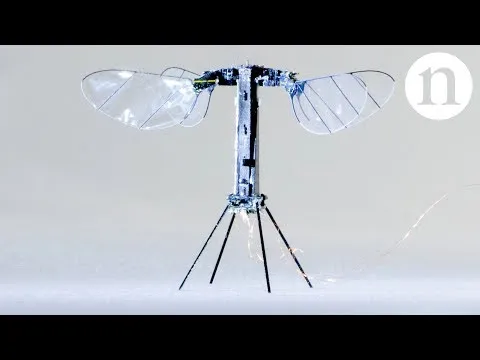How to ask for help, and get it; A solar powered insect-sized flying robot; Another dangerous bug in the MCAS software on the Boeing 737 Max ; A maritime revolution that was led by reptiles; The surface of Titan, Saturn's largest moon.
Straight from my RSS feed:
Links and micro-summaries from my 1000+ daily headlines. I filter them so you don't have to.
- How to ask for help -- and get a "yes" - In this TED talk, Social Psychologist Heidi Grant gives four tips for asking for help. It starts with recognizing that you're probably not going to get help without asking for it. Her tips start with suggesting that your requests for help should describe specific needs, and avoiding "disclaimers, apologies, and bribes." Her third suggestion is to avoid asking for help over e-mail and text messages - in person requests are 30 times more likely to get a "yes" than e-mail. Her final suggestion, that she says is very important, is to follow-up after receiving help to make sure that people know their help made a difference.
- A solar-powered robot bee shows how insect drones may take flight - A June 26 paper in Nature describes the first insect-sized robot to fly without a tether. It uses advances in material science and flapping wings for more efficiency and maneuverability. The robot is not ready for commercial operation because it requires an intense light source, and can only fly for a few seconds.
- You're not Boeing to believe this, but... Another deadly 737 Max control bug found - Boeing confirmed on Wednesday (June 26) that simulator testing revealed another bug that can steer Boeing's 737 Max into a dangerous nose dive. The article speculates on several possibilities: the MCAS may send the processor into an unbreakable loop, or it may halt processing by throwing an unhandled exception; A less likely scenario may be that the MCAS software triggers a bug in the CPU, itself.
- When Reptiles Led a Revolution in the Seas - At the beginning of the Triassic era, the Californosaurus was a type of Ichthyosaurus that emerged with fish-like features including fins, tails, and streamlined profiles. Their bones were reptilian, however, and their offspring were born alive. These and other emerging reptiles filled a number of niches that had been left vacant after a great die-off at the end of the Permian period. This time period, the Mesozoic Marine Revolution, was a sort of evolutionary arms race that led to a great increase in complexity of the relationships among marine Icthyosaurs and their prey. Sharks were around for millions of years before these fish-shaped reptiles appeared, and marine mammals like dolphins didn't appear until about 200 million years later, which implies that 3 different varieties of animals all converged independently on very similar aerodynamic shapes. Most of these fish-like reptiles disappeared at the end of the Triassic period, and the few that survived through the subsequent Jurassic period all disappeared during the early Cretaceous period. Theorists suggest that they may have been out-competed by other apex predators, or the climate may have changed in a way that deprived them of oxygen. h/t RealClear Science
- STEEM Methane rivers and acetylene shores of Titan. - Citing a report from the Astrobiological Conference in Seattle, @kuku12170 discusses unusual substances that may exist near the surface of Titan, Saturn's largest moon. These include organic compounds like benzene and acetylene in the atmosphere and in surface lakes. Because those substances are prone to evaporation, researchers have been attempting to explain the halos that form around these lakes. Now they have experimentally observed that benzene and acetylene are able to form mixed-crystals that don't evaporate. It may be that these mixed crystals form the sediment that causes the halos around the lakes. (5% of the rewards from this post will go to @kuku12170.)
- How might Grant's advice on asking for help be useful for new Steemizens?
- What practical uses can you imagine for an insect-sized flying robot?
- Will you be willing to fly in a 737 Max when the plane is restored to service?
In order to help make Steem the go to place for timely information on diverse topics, I invite you to discuss any of these links in the comments and/or your own response post.
For example, feel free to comment on any or all of these discussion topics:
About this series
Note: Sharing a link does not imply endorsement or agreement, and I receive no incentives for sharing from any of the content producers.
Follow on steem: @remlaps-lite, @remlaps
If you are not on Steem yet, you can follow through RSS: remlaps-lite, remlaps.
Thanks to SteemRSS from philipkoon, doriitamar, and torrey.blog for the Steem RSS feeds!

